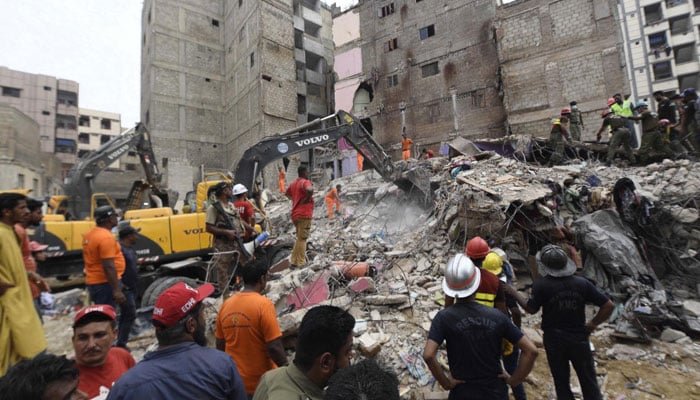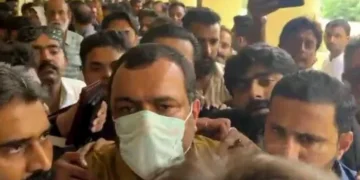KARACHI: The death toll from Friday’s tragic building collapse in Lyari’s Baghdadi area has climbed to 16, as rescue teams continue their frantic efforts to locate survivors and recover bodies from the debris.
Rescue operations entered a second consecutive day on Saturday, with authorities warning that up to a dozen people may still be trapped beneath the rubble. Heavy machinery and advanced devices like heartbeat detectors are being used to search for survivors layer by layer, making the process slow but meticulous.
The ill-fated, decades-old residential building housed more than 40 residents across 20 apartments before it crumbled suddenly in the densely populated neighborhood. So far, six women and 10 men have been confirmed dead, while three injured victims remain under treatment, hospital officials reported.
Amid scenes of chaos and grief, relatives of the missing have crowded the site, at times inadvertently hindering rescue operations. To maintain order, Rangers and city wardens have cordoned off the area to keep onlookers at bay.
District South Deputy Commissioner Javed Khoso stated on Saturday that the operation could take another eight to ten hours. “This building was declared dangerous three years ago. A formal notice was sent just over six weeks ago,” Khoso revealed, adding that 22 other buildings in Lyari are currently classified as extremely hazardous. Of these, 16 have already been evacuated, while efforts are underway to vacate the remaining structures. Legal action is being considered against those ignoring evacuation directives.
During a late-night visit to the site, Karachi Commissioner Syed Hassan Naqvi urged residents of structurally compromised buildings to relocate immediately. “We can’t forcibly evict people,” Naqvi admitted but pledged to raise the issue of illegal constructions in an upcoming meeting with the Sindh Building Control Authority (SBCA).
In response to the disaster, the Sindh government has constituted a high-level committee to investigate the incident. The committee is expected to submit its findings within three days.
The SBCA confirmed that the collapsed building was over 30 years old and had been marked unsafe years earlier. Evacuation notices were issued in the past, including on June 25, 2025, when utilities were ordered to be cut off—but neither electricity nor water connections were severed, and residents remained in place.
This tragedy highlights a recurring problem in Karachi: a series of building collapses since 2017, often involving illegal or decaying structures. According to SBCA data, there are currently 578 buildings in Karachi deemed dangerous and unfit for habitation. District South accounts for the majority (456), while others are spread across Central (66), Keamari (23), Korangi (14), East (13), Malir (4), and West (2).
Urban planning experts warn that mere notices and warning banners are insufficient. They call on the Sindh government to enforce evacuations proactively and arrange temporary housing for displaced residents to avert future disasters.














